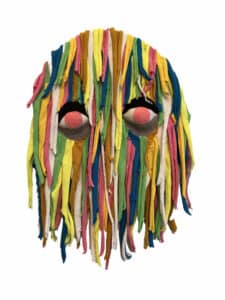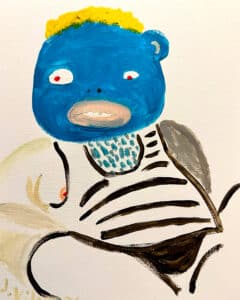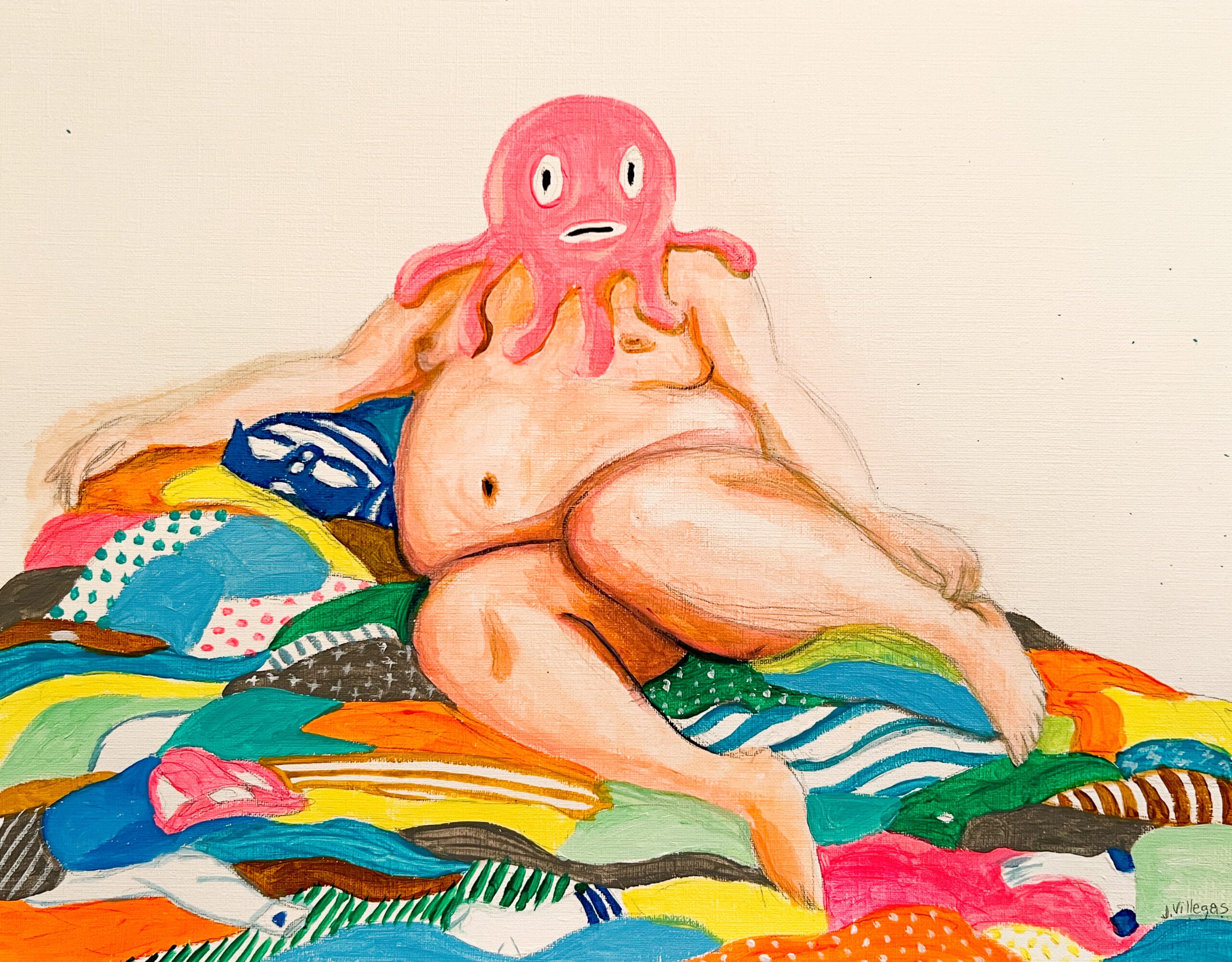Freedom of being who you are:
a Ramp Gallery interview with Jason Villegas
Q&A written by Rebeca Abidail Flores, Gallery Coordinator
a Ramp Gallery interview with Jason Villegas
By the grace of a low iphone battery and an Oakland cloudy sky, Jason Villegas talked with us on his latest exhibition in The Ramp Gallery—Who I Was & Want To Be. He shares his process, remixing fabric, and shares with us his ideas that sprout from cartoon influence.
SOMArts: We are very excited for your show, Who I Was & want to be. What inspired you to make the show?
Jason Villegas: It’s a collection of a few types of images and I thought they all worked well together. Their color scheme and their ability to tie into each other in terms of identity thoughts: how we express ourselves, how we think about ourselves, how we represent ourselves, how different and varied it can be, and how much we can change. Personally, I feel like I’m a lot of different people a lot of different times, and I’m always trying to explore lots of ways of expressing myself through my art.
These newest pieces are the reclining figures. I love going to the beach and the pool so, a lot of these figures are giving that hanging out on a beach towel vibe but I like to paint them in a way where they can represent a wide variety of people. As a queer artist, I’m always thinking about gender representation, gender identity, fluidity, and a freenes with how we express ourselves. The fabric pieces in the show tie in, the same way of thinking about our exterior, our skins, or avatars that represent ourselves.

Neon head, 2022
I feel like I’m at a place where I’m changing again, with my art and kind of coming out of this, shedding the art school efforts.
I’m an outsider artist at my core, despite going to school. Now, I feel more satisfaction from artmaking since simplifying my motives. It’s very queer. It’s fun. It’s subversive. It’s humorous, it’s sexuality, it’s gender, it’s all things that are my life. How I live and how I feel.
So, that’s why I like this little collection of works because it’s basically who I was, and who I wanted to be, also how I’m changing, and how I want to represent myself. I like to think that it’s a lotof truth.
SA: I liked what you said, “It’s how I live and how I feel.” Are the figures characters or personas, are they their own entities?
JV: I was really into Lacoste crocodile as this applique that makes a basic shirt more of a luxury item and its counterpart. Then there were all these little other animal appliques that were like that. So I built up this whole world of this kind of spiritualized consumer cult culture around these animals. Also very much about the spirit animals and more indigenous artworks that I was borrowing from. In that respect, there’s one piece in there that has this head with ears that are kind of coming off the sides. And that’s based on this rabbit applique. These ones are kind of the characters that I’ve made.
Now I’m just trying to become more loose with them. Those motifs are going to always be there because I like doing them. But I’m not really thinking, “oh, the viewer needs to know all this,” it’s more of a mask, the helmet, sort of odd character that you can appreciate on its own, just as it is.
The colorful reclining paintings, the gestural figures, they are completely from that moment. I like the freedom of it not being planned. They’re not anyone. Maybe they’re all a little bit of me inside, maybe they’re when I’m feeling sassy, or when I’m being, you know, thirsty, or you know, who knows when I’m out there in my speedo, like being body positive and chubby in the world. I think it’s just about this freedom of being who you are.
SA: Is that why you came to art?
JV: I’ve always been doing art since I was a child. It’s been a natural interest and ability. People are trying to figure out what they’re doing and why they’re here. We contemplate these things. The world is really hard for artists and trying to live. You come to this point, when you get older, and you go, “Man, should I have been a doctor?” But the reality is, it is who I’ve become and you know, it’s not easy. But I don’t want to call it a calling because it’s kind of like cliche, but that’s just how I came to it. I do think that it’s very therapeutic and I always feel a great sense of accomplishment when I work on big shows or time intensive sculptures. I also feel a wonderful feeling of expression and peace when I do these super gestural fast paintings like the pieces in this show. I almost love them more. Sometimes a few strokes of paint can make you feel a lot more than months of work on something else. And that’s the great variety of it.
SA: If you were to put your finger on why that is. Is it the risk or the immediacy, what do you think it is?
JV: I think a lot has to do with a little bit of rebelliousness. The world values, real time instances, really detailed works, high end things, and like, oh, this cost $10,000, just to make. There’s a rebellious part of me that loves that I can feel a lot more pleasure from a quick, quick, doodle with paint on a piece of paper. There’s always these scales of like, when you’re thinking about your work, “oh, is it enough? Am I a charlatan? What am I getting away with here?” But I think if it’s just bringing you pleasure through your expression, I think that’s very valuable.
Since the beginning of culture and civilization, people were marking things and telling stories, recording history, and sharing experiences through art making. It’s almost like offspring, you know, you’re leaving something there. You’re passing on something and it’s gonna influence other people. And it’s going to change the world, even if you can’t ever see it while you’re alive.
SA: How are you influenced?
JV: I’m always seeing works that inspire me and I’ll remember a quality about it like a color palette, texture, an expression, a character’s face, something that makes me think of something on my own to do or, you know, we’re always stealing a little bit of here and there.

Nip slip, 2022
I’m also very inspired by cartoons and animation. I grew up watching 80s cartoons like Voltron and, Thundercats. Like the materials I’m drawn to, I’ve always been a thrift store hunter. I like recycling materials and I sort of have a love hate also with fashion. Fashion and clothing has always been a part of my stuff. Stealing logos and changing them for my own needs has always been a part of my work. I love the craziness of human civilization. I’m always inspired by all the nuttiness that we do and that we believe in. It’s all inspiring for my work because I definitely like to touch on the humor and absurdity of humanity and as well as the beauty and the good stuff.
SA: How do you find which fabric pieces you’re going to use for remixing?
JV: When I’m deconstructing a piece of clothing, it’s kind of this ritual where it’s like skinning an animal. I’m separating the flat pieces from all the trim, the surging, the connections, the buttons, the color, so you’re creating all these components, and then you use the skin for certain things, you use the trims for other things. The pieces themselves tell me to do things with them, like, these might look great as a tank wheel, or these buttons will look good as a weird cell phone or organ. A lot of times, I let the fabric speak to me and say what it wants to be and then I’ll do the piles with the eyes. I’m always switching and trying to see which way the colors look best and, maybe, I’m leaving the lace on there that says how to wash it or something. You know, it’s stuff that happens in the moment.
SA: It’s like an in process of play and remexing. Tell us what’s next and do you have any advice for anyone who’s just starting as an artist?
JV: Ceramics is another thing that I love to make and sometimes it incorporates the fabric work. I’ve been having some new ideas for less figurative work that are more sort of surreal, abstract combinations of things. I like tapestries a lot, just weird stuff, sculptural elements, texture and strangeness. I’m just really trying to do more here and get my work out there anywhere I can.
I think my biggest advice, which I had to learn, not to be too hard on yourself. Don’t pressure yourself. Don’t compare yourself. With social media it’s really hard for us to not do that. You can get super discouraged and you can let something that you love bring you a lot of unhappiness. The reality is art should be for ourselves. First, yes, we’re here to share it with the world. But it’s for you. So, as long as you’re always making yourself happy, you can get rejected, you can cry and try again.
To learn more about Jason’s work please visit his website
Jason Villegas exhibit, Who I Was & Want To Be is on view from August 4th – September 18, 2022. To learn more about his exhibition please visit here.

